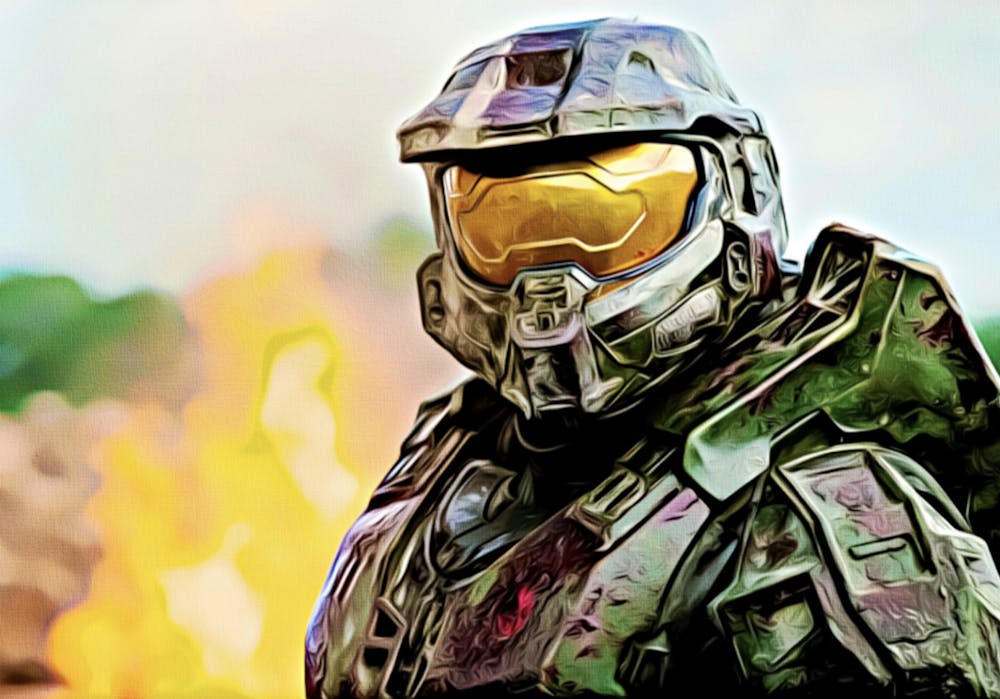“Halo,” a sci-fi adventure series inspired by the first-person shooter video game franchise of the same name, hit Paramount streaming services in late March. Given the often negative reputation of movies based off of other media, the desert sands in the opening shot of “Contact” — the series’ first episode — evoke and validate feelings of both nostalgic enthusiasm and concern for long-time fans of the franchise. For newcomers, “Contact” is an hour of mildly enjoyable confusion that throws two decades worth of exposition at viewers at once.
The general premise and major players of “Halo” closely resemble their video game counterparts. Exploring galaxies on behalf of the collective interests of planet Earth in the 26th century, the United Nations Space Command is an interplanetary military force that the player fights for. Individual planets colonized by humans have taken issue with the UNSC’s governance and have formed insurgent militias across space that have played a minor role in the games. The UNSC’s most prominent foe is the Covenant, a coalition of alien races with varying motivations to eradicate the human race.
The first 18 minutes of “Contact” follow Kwan Ha, portrayed by Yerin Ha — the daughter of the leader of an insurgent militia on the planet Madrigal, which is mentioned a handful of times across the franchise’s history, and a character original to the series — as she flees for safety from an invasion by the alien forces of the Covenant.
The slaughter is slowed by the arrival of the armor-clad war machine Master Chief, portrayed by Pablo Scheiber, the character the player controls in the video games and an emissary of the United Nations Space Command. Master Chief and his squad of Spartan super-soldiers quickly dispatch the alien forces in a flashy firefight.
Leaning doubly on allusions to established Halo lore as well as very obvious departures from the basic facts of the franchise’s universe — like the portrayal of the usually benevolent United Nations Space Command as an interventionist imperial mega-state — “Contact” manages to eke out a watchable premise.
The rest of the episode deals with the fallout from the attack on the planet Madrigal, of which Kwan is the only survivor. Introducing characters like Dr. Catherine Halsey, portrayed by Natascha McElhone, and Dr. Miranda Keyes, portrayed by Olive Gray, the pace of the show abruptly slows to a crawl peppered with references to the games meant to keep viewers watching.
“Halo” has a heavy reliance on familiarity with the games that bleeds into the way the series looks. While other franchise adaptations bury themselves in visual realism to give themselves legitimacy, “Halo” looks like an animation using models from the video games. Planets and starships closely resemble set pieces from the video games but their colors have been toned down.
In stark contrast, both the aliens and the Spartan super-soldiers look and move exactly like their video game counterparts, leading to a strange disconnect between the characters and their surroundings that looks regrettably amateur for an episode that reportedly cost $10 million to produce.
This adherence to the source material ultimately leads to an almost lifeless narrative, as exemplified in the show’s version of Master Chief. Master Chief is a masked, no-nonsense blank slate meant to empower players to feel as if they actually were the super-soldier they were controlling without the cognitive dissonance that a fully fleshed-out character would evoke.
His lack of a personality offers very little to work off of, leading to a sorely mechanical characterization from Pablo Schreiber. However, if Paramount has plans to develop Master Chief’s personality, Schreiber is the perfect choice for the role after solid performances in “Orange is the New Black” and “American Gods.” While he might not have had much time to flesh out Master Chief in his first appearance, viewers can take some solace in that Schreiber feels “a sense of responsibility for sure.”
Despite a talented cast, dialogue is often awkward as the series falls into the science fiction trap of overusing jargon instead of actually explaining what is happening. Concepts that are wholly original to the show are introduced with the same expectations of viewer understanding as those well established over the franchise’s history.
For instance, “Contact” introduces the phrase “Article 72” as the United Nations Space Command code word for murdering a political opponent, which is not apparent to viewers the first few times the phrase is mentioned. By the time the phrase has been explained, the gravity of the situation it accompanies has been ripped apart by the almost comical way a wide-eyed Keyes repeats the phrase several times in 20 seconds.
The tedium of the exposition played out in “Contact” showcases exactly why Halo was conceived as a video game and not as an early 2000’s sci-fi blockbuster. For viewers that have played the games, the entire first episode feels like a cutscene to be glossed over before being able to actually do something. The carnage of the firefight on Madrigal was gratifyingly gratuitous to watch, but pales in comparison to what the player can achieve given a controller and a well-designed level.
Nostalgia and mild intrigue seem to be the two strongest reasons to watch out for the next episode of “Halo,” which will hopefully give viewers more to look forward to.







